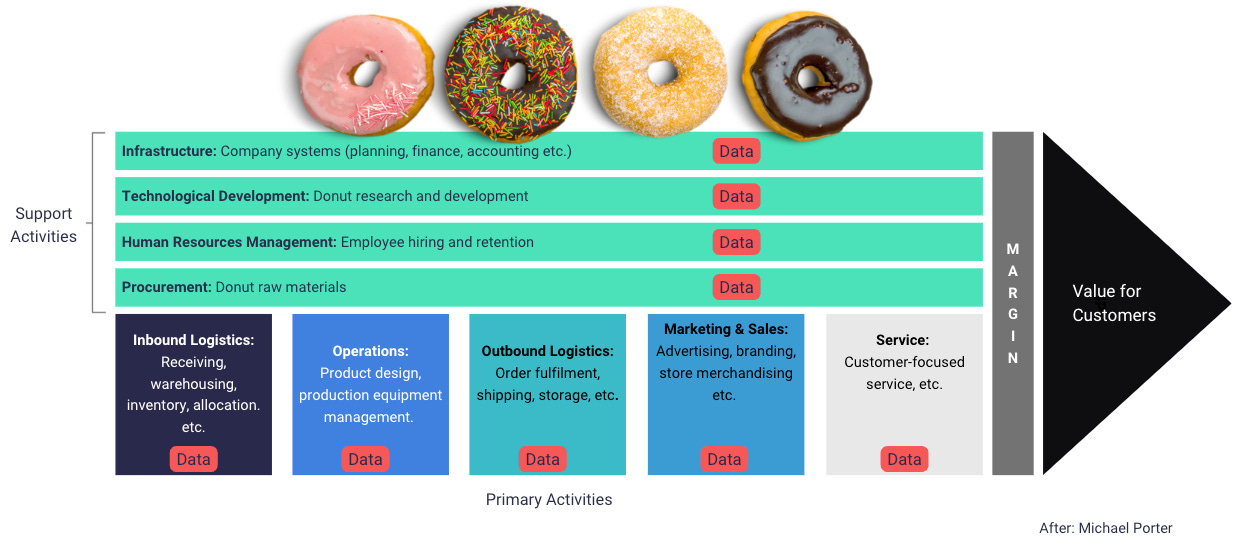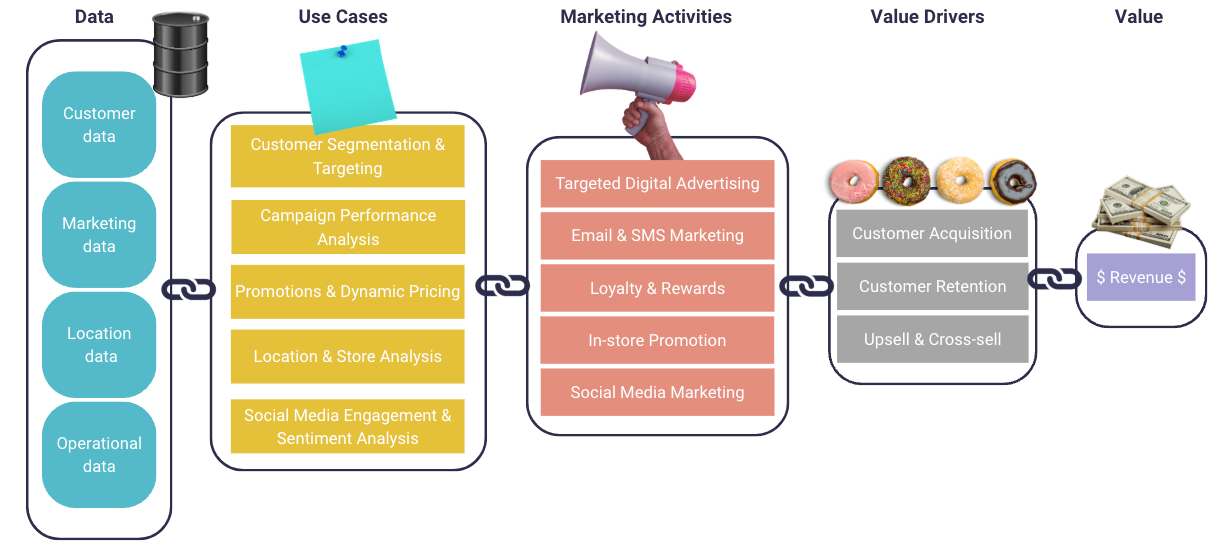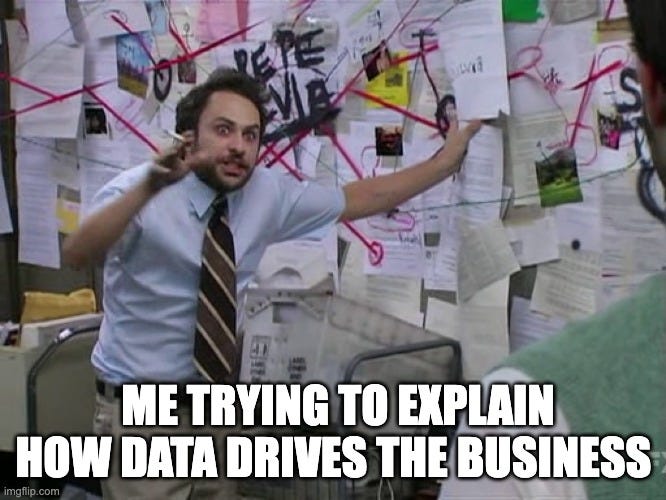#4 When business meets data
Let's connect 🤙
Let’s give a DAM
My catchphrase ‘business of data’ describes the general vibe of this newsletter, but it is, in part, code for a more formal science you may not have heard of.
Strategic Data Asset Management (let’s just call it DAM for short).
To be fair, this newsletter project extends further to other business fundamentals, but DAM is slap bang in the middle of it.
It is very much first principles stuff.
DAM is a straightforward concept, although the execution of it can require a significant shift in mindset for organisations that treat data little more than a cost of doing business.
But I digress.
DAM is the intentional management of data as a critical business asset.
What does this mean?
Well, if your data is an asset, it must have value. This means it draws its value from the actions and decisions your organisation uses it for, in pursuit of its business objectives.
It also means that the emphasis of managing it is on making sure it is fit-for-purpose - for your value creating activities (however they are measured).
This also means it is actually used for the purposes it is designed for (a weird thing to say, but this isn’t always the case).
Putting the Asset into Data management
Data management, as traditionally applied, has a bad rep.
Too many organisations, especially those outside highly regulated industries where data management is hard wired, tend to see only half of its equation - its cost. While the benefit side of that same equation is often ignored, misunderstood, or just not believed.
This isn’t a new problem. It’s been around as long as I’ve been working.
Every data leader would dearly love to see data management accepted as an enabler of business value, garnering the attention and respect it deserves.
But, alas, I wouldn’t have been kept busy fixing data strategies, if this were true.
I risk falling into a deep hole here, so I’ll tread carefully. But, the challenges facing data management are a common refrain on LinkedIn and in closed networking groups of seasoned data leaders.
There are a few reasons why data management is seen primarily as a cost, but I’ll cover two of them (briefly).
First, (and here I tread gingerly - dare I awaken the Dragons of Data Management), an overly bureaucratic and technocratic approach to this capability, has tended not to inspire those who should and indeed need to care about it.
It doesn’t always work, but at least I try…
The sell often lacks sizzle ♨️.
There are many notable data management professionals who are doing sterling work to improve both the standing and understanding of this vital capability.
Some may regard my characterisation of this problem as tired and annoying.
(I’ve been in the business of annoying my data management pals ever since I built my first data model - centuries ago).
But as always, I only report what I see. And this is an old, old problem.
The second, and related issue, is that while many people now talk up data management and actively try to sell its merits, evidencing these merits (or tangible benefits) is easier said than done.
Enter DAM
DAM is data management. But data management explicitly focused on business value.
The costs and the benefits.
The DAM approach, at its simplest, turns data into a bona fide business activity, because it requires us to understand data through the lens of value, balancing the costs of fixing it with the benefits of using it.
It holds data up to our most important priorities and forces us to ask:
“Is this data important - what opportunities and risks does it offer?”
“What is this actual, measurable, value to our business?”
“What do I need to do to make it fit-for-purpose?”
“Is investing in this data going to drive benefit?”
and “…will this investment pay back?”
Successful DAM means you’ve achieved some important things:
✅ You have connected your data to the value it drives
✅ You have measured the value of your data
✅ You have prioritised your investments in data
✅ You are proactively managing your assets for sustainable value creation
✅ You are doing all of this, because you are leading data as a business activity
✅ Your data is delivering real and measured value to the things that matter
Every data transformation I’ve seen fall over, or at least stumble, has done so because it has not been treated as a business endeavour.
In other words, DAM has not happened.
There is a cascade of chaos associated with this, that runs roughly like this:
❌ Your data is too loosely tied to business outcomes (or entirely untethered)
❌ Meaning you don’t actually understand the real value your data drives
❌ So, you have little hope of prioritising investment in it
❌ Meaning you can’t manage your data effectively to support your business
❌ So, you fail to exploit the opportunities or deal with risks that face your business
❌ Meaning people don’t treat data seriously, and it remains a costly annoyance
😭 So, we’re all depressed, frustrated, and looking for a new job.
Scaremongering? Not really, this is happening across sectors, across the world.
DAM is a chunky subject and will come up again and again in this newsletter. It will keep me busy until I’ve exhausted the topic (possible), retired to the south of France (unlikely), or I’ve pissed off most of my subscribers (very possible).
For now, let's unpack the first principle of the business of data (or DAM) - connecting it to business outcomes.
FYI - The Data MBA isn’t a ‘how-to-guide.’ I will sometimes stray into a bit of ‘how to,’ where it's warranted, but my main objective is for you to think differently about the business fundamentals of data.
Think connection, not alignment
I try to stay out of the endless debates over definitions that goes on in the data bubble, mainly because the business bubble (which we should all be in), doesn’t care.
But this one is worth the argument, as I think whichever side you fall says a lot about your assumptions about the role of data.
Here’s a phrase you will hear a lot:
“You need to align your data strategy with your business strategy.”
The sentiment is right, but as far as I’m concerned, alignment is too passive an ambition. It hints at data taking on a subordinate role, setting itself up in a predefined structure to match existing business strategy - a lackey, trying to stay close to its master.
Smithers to the business’ Mr Burns.
My preferred approach is to talk about connection. For me, this is much more proactive and speaks to the real role of data and information, as active flows connecting all the components of your business ecosystem.
Let’s look at this strategically. Connection is adaptive. This means when we’re looking at how to manage data, we need to see it as continuously tied to business outcomes at the right points, ties which adapt and flex as business demands pivot and evolve.
This is much more than alignment.
A connective approach means our ambition is for data to be almost immediately responsive, even predictive, of business needs. Alignment tends to suggest data is forever playing catch-up, somewhere behind or to the side of the business.
Let’s quickly consider this from a technical perspective as well. If data and information are the lifeblood of a well connected business ecosystem, the technical enablers of data (people, processes and technology), need to be implemented in such a way to sustain actual connection.
This, infrastructure (as we might loosely call it), needs to ensure data and its capabilities, are digitally, physically, and operationally connected so your business can take the actions and decisions it needs to run itself.
(As an aside, this adaptive and responsive mindset also sits behind practices like data product management).
Think of it like this. With alignment you are trying to get a data strategy to support a business strategy. With connection we’re talking about a data enabled business strategy.
Think value chain
So, understanding exactly how data drives your business is more than just aligning it to your organisation’s outcomes. It means connecting your data to the things that matter.
This means that you need a clear understanding of how data connects to your business’ value chain.
Your business’ value chain is a series of activities that make it possible for your organisation to deliver whatever product or service it exists to create.
This business school 101, coined by Michael E. Porter of Harvard Business School, is a model that includes every step an organisation goes through from an initial idea through to delivery of a good or service.
It is a concept that began with physical supply chains, but is equally applicable to any organisation that creates value for its stakeholders.
Here’s an example business value chain for a fictional donut (doughnut if you’re a Brit) retailer.
The donut business value chain
It doesn’t take a genius to realise every key activity within a business value chain is underpinned by data and information.
Okay, this is purposely high-level to make a point, and so I can plaster the word data over everything.
Let’s increase the resolution
To bring this point of connection home, we can hone in on one part of the donut value chain.
In this example I’ve restricted the view of the business value chain to some key marketing activities.
A simplified example - to make the point
If we work backwards, we know our marketing activities, like all marketing activities, focus on driving incremental revenue. The key value drivers being customer acquisition, customer retention and upsell and cross-sell. Think of these as levers we can pull to create more financial value for our donut retailer.
Our marketing function is focused on a handful of key activities to drive value, such as digital advertising and in-store promotions.
These are founded on business capabilities or use cases (to use a common term), which need to happen to drive these activities, such as customer segmentation and store analysis.
These use cases depend on, you guessed it, data. In this case various types of customer, marketing, location and operational data. All of the decisions and actions taken by marketing depend on it, and ultimately our value creation depends on it.
The relative value of our data depends on the degree to which business activities are dependent on it.
This is a very simple example, designed to illustrate the point. If we’re going to treat data as a business activity, then we need to firmly connect it to, well erm, our business activities.
In reality, business value chains are far more nuanced. For a real donut retailer (or any organisation for that matter), we’d need a more granular view of our data (there are multiples types of data that fall in the customer bucket, for example), and we’d likely need to map out many more use cases and business activities.
Detective Data 🕵️
Mapping a business value chain is a real piece of detective work. You’re essentially revealing the map of an organisation, connecting data, and identifying multiple value streams.
You’ll find that there will be lots of cross-over between use cases, and data will be shared right across your chain. Multiple activities will have a greater or lesser dependency on a specific pot of data
It is likely you will be able to associate lots of slices of impact to your critical data. This is how you start to build up a picture of the overall value it is responsible for.
You need to be at once holistic and detailed. You need to know your data, how it is used, the data needs of key activities, business value drivers, stakeholders, the whole shebang.
The eagle-eyed amongst you may have noticed I’ve not actually told you how to do this or how to value your data. I’ve just shown you the rough route to it.
The truth is this is a complex undertaking for even a smallish organisation, and there are secret sauce valuation methods that will get you there.
(Get in touch if you want to know more - my organisation Anmut does this).
Some things to consider
Always work backwards from value to the data: if you start with trying to shoehorn your data into uses, you’ve fallen at the first hurdle. The trick is to look at your business objectives (e.g., create more revenue) your value drivers (e.g., customer acquisition), understand the activities they depend on (e.g., digital advertising), the capabilities you need to inform these (e.g., customer segmentation), and at the base, the data required to power these.
This will help you prioritise resources: the chances are your organisation has a lot of data, at least the data you know about. Even small organisations can have a surprising volume and variety of data lurking in their digital cupboards. Visualising your business value chain and understanding the dependency of activities on data will help you prioritise what you need and what you don’t.
Following the value chain back to your data will help with prioritisation. I appreciate I’ve not given you a method for this, but a feel for benefits will help you make a better investment case for - time, people, tools.
You need to get a bit obsessive about value drivers: connecting your data activities to these is vital, and is something surprisingly missing from a lot of data strategies. Every organisation has performance indicators (lagging and leading), and your route to demonstrating the value of your data is by connecting through the chain to these. Any CFO worth their salt will want to see at least some effort to make this connection.
Final words
This is a huge subject and I’ve remained in helicopter mode throughout, on purpose.
There is always a major difference between talking and doing, but I can confirm a DAM mindset, is the route to connecting business and data.
One of the key implications of this mindset is it means data leaders need to know their business, and I mean really know it.
A key part of the role is to understand how your data connects to business value, and to prioritise and invest accordingly.
I’ve always argued that data leaders are one of the few executives who need a root and branch understanding of their business and how it operates. This mindset reinforces this.
However, what if you’re a data-curious business leader? Well, this approach helps crystallise the role of data in the things that matter to you. I’ve always argued the ‘deadliest’ business leaders are those with a strong sense of the power of data.
If you care about making better decisions and actions, then understanding the role of data in your business will only help.
Right, that will do for this week.
If I’ve managed to get at least one person to see things a bit differently - I’m happy.
Cheers.






